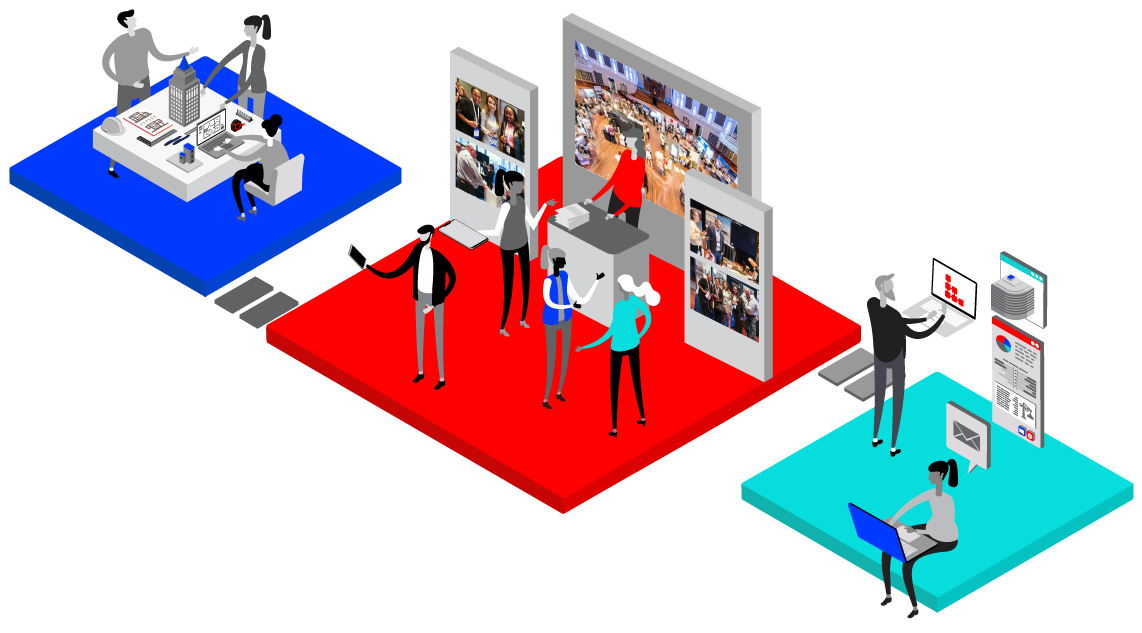- Rumah
- >
- 3 Ways to Effectively Generate Construction Leads
3 Ways to Effectively Generate Construction Leads

Identifying and connecting with new potential customers in the design and construction industry can be difficult. The first step is having a solid understanding of who your prospects are and what drives them, coupled with the right tools and approach to market.
Want to take a version of this article to go? Download our 3 Ways to Effectively Generate Construction Leads eBook!
How To Generate Quality Construction Leads
We’ll tackle some of the ways to identify prospects and how to leverage your existing network for more business, as well as best practice on preparing for an introduction.
1. Identifying Buying Personas and Their Values
It’s important to know exactly who you’re targeting. Identify your ideal target market by asking yourself:
- Who are my ideal clients?
- What types of projects do they work on?
- What do they value, and how does my product/service deliver in these areas?
Your value points will change depending on who you are speaking to!
Some example value points could include:
- Cost
- Country of origin
- Lead time
- Aesthetics
- Innovation
- Previously specified
- Safety
- Sustainability
- Technical support
- Warranties
- Product variance
- Third-party testing
Your product may address the key values or considerations of multiple buyer personas; however, the pitch will change from one to the other. It’s important to communicate only what’s important to the prospect at hand for maximum impact. And to do that, you need to understand how your prospect’s role within a project will influence their values or considerations come product selection.
We’re going to take a look at three buying personas: Architects, Main Contractors and Subcontractors. Remember, because they have different roles and make decisions at different stages of the project, they are going to value different things when it comes to product selection and purchase.
As an example, we could be selling the best-looking product; however, if we’re a cost-effective solution and are ultimately selling to a subcontractor or installer, we won’t be pitching our product on aesthetics as that might be more in line with what an architect would consider earlier on. Rather, we’ll be pitching our payment plans and lead times.
Arkitek
Starting with architects, as they typically have the earliest involvement of the three, their decision-making or “buying window” for fixtures, finishes, structural products etc. is usually in the very early stages of a project. Architects will never purchase the product themselves but can be cost-driven depending on the project budget. Main contractors and subcontractors/installers typically come into the picture once product specifications have been locked in.
Below are a few key values or considerations that are very common among many architects. In other words, this is what architects are going to be considering during your product pitch:
- Fit for Purpose
- Does this product suit the project brief, functionally and aesthetically?
- Does it meet standards?
- Is it better than what I’m currently using?
- Cost Effective
- Does this product suit budget?
- If margins run tight, are there equivalent products available at a better price?
- Certifications
- Does this product come with certifications?
- Are they up to date?
Main Contractors
Main contractors, to an extent, work off the product selections made by architects. Their values or considerations during a product pitch or when reading the schedules might include:
- Cost
- Does this product fit budget or should I be looking for an alternative?
- Reliability/Dependability
- Does this product have a good track record?
- Why should I move from a product that I trust and has worked for me in the past?
- Warranties
- Does this product come with a warranty?
- If so, for how long?
- Lead Time
- Is this product available?
- Is the product made locally?
- If not, how long does it take to order?
Subkontraktor
Subkontraktor are engaged by the builder and will work off the tender documents provided to an extent. A subcontractor’s values and considerations during a product pitch or when reviewing the tender docs might be more in line with a builder; however, seeing as they are the ones purchasing and installing on site (again, playing a different role), they will also be considering:
- Payment Terms
- Do I have to buy this product outright?
- Is there a payment plan available?
- Cost
- Does this product fit budget or should I be looking for an alternative?
- Availability
- Can I get this product in time?
- Ease of Installation
- How easy is it for this product to be installed?
- Is it worth me moving away from a product I’ve been installing for years?
2. Identifying Prospects: Prospecting Strategies in the Design and Construction Industry
How do we identify specific prospects we can engage with? How do we know if that prospect has a relevant project on? And if they do, what is the project and its requirements?
To help you answer these questions, there are a couple of common methods and tools used in the industry: referrals/networking, tradeshows, LinkedIn and Pengurus Utama BCI. Keep reading for more information on each of these prospecting strategies.
Referrals/Networking
One of the most common and easiest forms of prospecting is simply asking your current network for referrals. It can seem like daunting conversation for some, but let’s break it down.
Let’s say you work for a manufacturer of a finishing product, and you look after 10 key architectural accounts. You’ve been doing a good job with these accounts—you get specified all the time, the main contractors you speak to retain your specs and the installers buy from your distributors. Everyone in the chain is happy. However, you’re only working with a handful of architects in each of those 10 accounts, when they employ hundreds.
It’s almost doing your accounts a disservice by not asking the architects you’re engaged with who else in their firm might benefit from your product. Sometimes it’s a simple a change of mindset that will allow for that conversation.
Tradeshows
There are many construction-related tradeshows available to participate in. Attending these can lead to a massive pool of prospects in a very short amount of time, especially when compared with door knocking or company drop ins.
Always be mindful of selecting the right tradeshow for you, as they often invite different types of prospects or “buying personas”. If you’re specifically targeting architects, Archify Live in Australia and New Zealand, or BCI Equinox in Asia are just some examples with a specifier-only policy for registration, so all attendees will be viable prospects.
Looking to cast the net a bit wider? Sydney Build (Australia), BuildNZ (New Zealand), Archidex (Malaysia), BEX Asia (Singapore), and IndoBuildTech (Indonesia) are all great examples of large-scale exhibitions that draw the crowds
LinkedIn can support both account management and prospecting. If you or your business don’t have LinkedIn, consider setting up a free profile.
LinkedIn can support referrals, networking and attending tradeshows in that:
- It provides an overview of employees within your key accounts, allowing you to introduce yourself instead of waiting on a contact to make the introduction for you.
- It allows you to look up prospects you meet at tradeshows and start engaging with them post-event.
From a new business or prospecting perspective, LinkedIn’s algorithm will make connection suggestions based on who you’re already connected with—so be sure to connect with prospects and accounts that are right for you. It also provides a breakdown of contacts within those firms to talk to. Of course, there are some limitations in that the information available only includes LinkedIn users, so it’s not going to provide 100% coverage, but can still be very effective.
Pengurus Utama BCI
BCI LeadManager helps you track projects and companies of interest, and then connect with design and construction decision makers at moments of influence in their purchasing journey.
- Account Management:
- Search accounts met at tradeshows or connected with via LinkedIn and see what active projects they’re working on
- Track your key accounts and receive future alerts, so you know when to reach out about upcoming project opportunities
- Identify other contacts working in your key accounts and ask for referrals in an educated manner, like when a colleague is working on a project your contact isn’t
- Track specifications to the point of tender, awarded and construction commenced to be able to pitch to other necessary project stakeholders
- Business Development:
- Project lists
- Company lists
3. Preparing for Introductory Calls
The thing that architects, main contractors and subcontractors have in common is that they are all incredibly busy with multiple projects and products. Leading with a phone call is an effective method of reaching out to your prospects, as are having social media connections such as LinkedIn. A combination strategy is the most effective.
When you pick up the phone, be prepared to have a conversation with your ideal client then and there. Have a relevant project opportunity that you want to discuss with them; this is where LeadManager is a great tool for uncovering the various projects your contact may be working on. However, also be prepared to leave a voicemail.
Leaving a voicemail demonstrates that you are not a spam caller, while giving you an opportunity to leave your name and details for future conversation. Keep why you’re phoning general and let them know it’s okay if they don’t phone you back as you are going to be sending them an email with more details.
Send that email within 90 seconds of your voicemail. Reference the message you left on the phone and include a little more detail about why you are wanting to talk to them. Try to bring something valuable to them, so you’re not seen as seen as someone asking for their time and attention without offering something that will help them in what they do day to day. This might be a subcontractor recommendation (who you know uses your product!), helping them reduce their time looking for subcontractors and putting more options on the table.
Not only this but look up their profile on LinkedIn. Just opening up their profile will send a notification to your contact.
The power lies in your follow up. So, don’t be disheartened if your email generates an auto-response; there is a lot of useful information to be found in these. When you next reach out to your contact, you can establish a deeper personal connection with them by referencing that annual leave they just took. Persistence is key.
Here’s a summary of each step for you to follow:
- Start with a phone call. Be ready to talk about a project they’re currently working on that you’re targeting.
- If they don’t answer, leave a voicemail, mentioning your upcoming email without revealing the content.
- Send an email within 90 seconds, referencing your voicemail. Include a value-add if you can.
- Use their LinkedIn profile as a social touch, notifying them that you’ve viewed it.
In just 90 seconds, you’ve left a voicemail, sent an email and engaged on LinkedIn, capturing their attention.
Conclusion
Identifying and connecting with potential customers in the construction industry can be challenging; that’s why it’s important to have an effective prospecting plan, not only to generate leads but to secure that next sale. Prospecting can come in many forms, whether that be through harnessing the power of referrals, attending industry tradeshows, or utilising LinkedIn to its absolute networking potential. Of course, we recommend our own BCI LeadManager to assist you in prospecting. The most important factor is knowing who you are trying to connect with and planning your pitch accordingly.
Looking for more ways to generate leads and grow your business? Why not get in touch with BCI Central, today!






